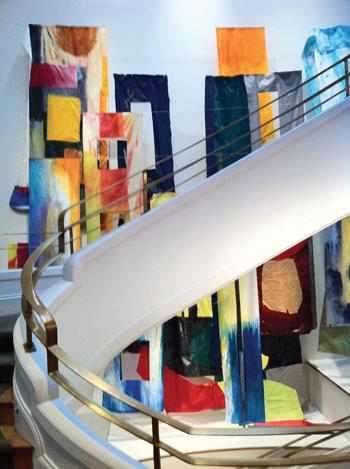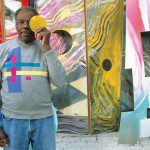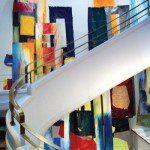Sam Gilliam & The Phillips Collection
By • July 26, 2011 0 2479

“Leonardo da Vinci wasn’t new,” says Sam Gilliam. “It’s the way that, in his context, he used all the information that he had that was very important in that particular moment. No art is really new in that sense.”
In a given conversation Gilliam’s historic references weave through centuries of artistic progress and evolution, envisioning the entire span of art history up to now as a sweeping landscape to be absorbed at one time. One of the last vestiges of Washington’s original visual arts community from the 1960s, Gilliam has long been known for his involvement with the influential Washington Color School—among painters like Morris Louis and and Kenneth Noland—and for innovating the unsupported canvas, which challenged preconceived categories of art.
He does not discuss his artistic influences without referencing the influences of those artists, and does not credit one artistic innovation without mention of its catalysts. “You can’t know the present or future without knowing the past,” he says. “Then you build your own concepts.”
With a loud and wielding intellect, Gilliam touts art as an ideal to achieve, as a fundamental in itself. He believes strongly in the future, education and progression of art, but is openly distressed over its current state. “In 1968,” he says, “more and more young people started trying to become artists in this city. There was a very good art scene in Washington… But the scene here almost failed two or three years ago when the 14th Street galleries mostly closed—the good ones, like G Fine Arts. And the NEA hasn’t gotten around to giving any grants to the visual arts.”
His worries are supported by a 2008 Survey of Public Participation in the Arts conducted by the NEA, which reported a 5% decline in arts participation by Americans since the previous survey (2001-2002), noting that “rapid advances in technology had enabled more access to arts events and arts creation through portable devices and the internet.”
Dwindling interest in the arts is not a new conversation, especially within painting and the visual arts, which has been proclaimed dead innumerable times since at least the days of Abstract Expressionism. But connecting with the past and finding shared ground within the rocky historical terrain of visual art is just what propels Gilliam and his work into the future.
This is showcased in his current installation at The Phillips Collection, coinciding with the museum’s 90th anniversary, where his site-specific painting for the museum’s elliptical staircase (on view until April 24) hangs adjacent to a gallery with works that Gilliam chose by Arthur Dove, Jackson Pollock and John Marin, using the canon of American painters “as a way of defining what’s going to happen in the future.”
Dove’s artwork, specifically his painting “Flour Mill II” (1938), are profoundly influential paintings for Gilliam, who first saw the work at the Phillips in the early 1960s. His current installation is a direct response to the painting, bridging history and influence and reviving the past in a candid and innovative way.
As a painter who has never abandoned his city, Gilliam’s installation at The Phillips is an achievement for the Washington art community. His first show at the Phillips was in 1967, and since then he has been active in the international art scene while remaining devoted and influential to local artistic circles. This installation reinforces the community among the city’s visual arts efforts and breathes new life into the Phillips as a contemporary art museum.
While he hasn’t worked with the Phillips in a major way since his 1967 exhibition, Gilliam notes The Phillips as a source of inspiration and study throughout the years to which he has returned frequently, using the museum’s collection to inform his own paintings. “The Phillips was showing art that was very inspirational when you first came to Washington in the 60s. I would go back for Morris Louis, Pollock, Georgia O’Keeffe, Man Ray, Van Gogh, George Braque…”
Despite setbacks and economic instability, Gilliam sees promise in Washington’s art scene. “The Phillips was just born again,” he says. “So was the National Gallery. In a sense, so has the Hirshhorn. There are new curators there and people that will put things before you. They are really set to take off. The only thing that they don’t have is as many bars as they used to have on Connecticut Avenue—more places to converse.”
Sam Gilliam’s intallation will be on view at The Phillips Collection through April 24. Also on view is an exhibition of artist David Smith, who Gilliam credits as a major influence of color field painting. For more information visit PhillipsCollection.org
- Nora Birch
- Sam Gilliam’s installation in the Phillips Collection, on view through April 24 | courtesy of the Phillips Collection



